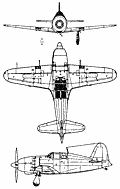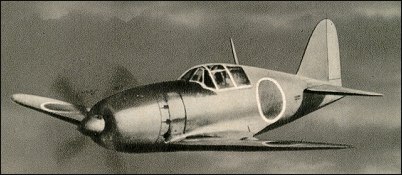|
| Although designed to a 1939 requirement,
at a time when Japanese war
leaders scarcely imagined a situation
requiring a home defence fighter, the
Mitsubishi J2M Raiden (thunderbolt)
only came into its own while defending
the Japanese homeland against American
raids in the last year of the war.
The Japanese navy's emphasis upon
speed and climb rate, rather than its
customary demands for range and
manoeuvrability, prompted the designer
Jiro Hinkoshi to adopt a squat single-
engine design with long-chord radial
engine cowling, laminar-flow
wings and high-raked, curved windscreen.
First flight of the prototype
J2M1 took place on 20 March 1942, but
the aircraft soon attracted criticism
from navy pilots on numerous counts,
not least that the view from the cockpit
was inadequate. Modifications to rectify
these shortcomings were delayed
owing to Mitsubishi's preoccupation
with the A6M. Production J2M2 fighters
left the factory slowly and entered service
with the 381st Kokutai late in 1943,
and were followed by the J2M3 with a
stronger wing stressed to mount four
20-mm cannon. The heavier armament
now restricted the performance of the
Raiden to the extent that it no longer
met the original demands, and the
J2M4 was an attempt to restore the performance
by including a turbocharger.
The final production variant, the J2M5
(34 built), was powered by a 1357kW Mitsubishi Kasei 26a radial.
In all, 476 J2Ms were built. In acknowledgement
of the fact that J2Ms could
not combat the Boeing B-29s at their
operating altitudes, some J2M3s were
armed with two upward-firing 20mm
cannon in addition to their wing guns.
(The Allies selected the reporting
name 'Jack' for the J2M).

| MODEL | J2M3 |
| CREW | 1 |
| ENGINE | 1 x Mitsubishi "Kasei-23a", 1350kW |
| WEIGHTS |
| Take-off weight | 3435 kg | 7573 lb |
| Empty weight | 2460 kg | 5423 lb |
| DIMENSIONS |
| Wingspan | 10.8 m | 35 ft 5 in |
| Length | 9.95 m | 33 ft 8 in |
| Height | 3.95 m | 13 ft 12 in |
| Wing area | 20.05 m2 | 215.82 sq ft |
| PERFORMANCE |
| Max. speed | 580 km/h | 360 mph |
| Ceiling | 11700 m | 38400 ft |
| Range | 1900 km | 1181 miles |
| ARMAMENT | 4 x 20mm cannons, 120kg of bombs |
 | A three-view drawing (752 x 1184) |
| icepac, e-mail, 26.06.2009 16:22 Regardless of plane type, the kill ratios have more to do with the ratio of planes in the sky. Near the end of the war, it was common to see the japanese planes outnumbered by a huge margin which gives a large advantage to the side with the numerical advantage even if the equipment is near equal in performance. It was the winning tactic vs the japanese........that and boom and zoom.....which again favors the force with larger numbers. reply | | Charles, e-mail, 18.04.2009 00:55 Best Japanese fighter of WWll was the Reppu. Seven were made one flew at the very end of the war. Apparently it was an equal to the P-51 reply | | Glenn, e-mail, 03.04.2009 07:53 All this in entertaining & facinating! I bet noone on here knows the best Jap fighter of WWII. If anyone can guess, put yer reply on here. reply | | Tom, e-mail, 28.11.2008 21:05 Wonderful plane against late world war 2 USA fighters. reply |
|
| | Mick Dunn, e-mail, 23.11.2008 07:13 You got that right toolkeeper! Jack was a handy little interceptor! One famous IJN Lieutenant I know of, who lived in a local Geisha House with a direct phone line to his airfield, used to hold up fingers before takeoff, predicting the number of P51s or Helcats he would shoot down. More often than not, he would have to open more fingers on landing!
Apparently not one bullet ever hit this guy's aircraft in all his arial combats! I might add that our hero was a bit on the pudgy side and the Raiden was the only fighter he could get his fat ass into!
I will dig back through my files and find his name....pretty sure it was Saito. His nickname was Japanese for Fat Pig!...not as derogatory as it might sound. reply | | Ronald, e-mail, 14.11.2008 06:40 Interesting to find the Jack did better against the F4U Corsair than the Zero (12 to 1), George (13 to 1), or Frank (7 to 1) in win-loss-ratio.
Only 3 lost for each F4U shot down against an 11 to 1 average for the Corsair overall. Likewise for the 19 to 1 F6F, other Japanese fighters were less successful than the J2M. In this case 3.7 to one in favor of the Hellcat vs Jack. Next best was the Ki 84 Frank at 9.5 per F6F shot down. The A6M5 was 13 to 1 (about 4 x worse than the Jack against both US fighters).
The J2M5 had four wing-mounted 20 mm Type 99 Model II cannon. Now all four wing cannon were harmonized in trajectory and ballistics performance like the Shiden fighters, but with more ammunition than they had (200 v. 70-125 rpg). The 20x101 cartridge gave the 128 g HE (8%) projectile an effective range of 1,000 m and a muzzle velocity of 750 m /s. The rate of fire was only 500 rpm each however (down from 520 rpm for the Type 99 Model I which only had a muzzle velocity of 600 m /s and a range of 730 m with its 20x72 cartridge). The earlier J2M3 had 2 of the Model I and 2 of the more powerful Model II cannons.
Initial climb was 3838 ft /min. and it took 6 min. 14 sec. sustained climb to reach 6 km (19,685') altitude. Speed improved to 382 mph with the J2M5 from 365 mph (only about 40 built before war's end). As an interceptor the Jack was much like the Nakajima Tojo but with more ceiling and alas, without it's all-around canopy. For such a contrast to the more vulnerable Zero, the Mitsubishi Jack was still agile by non-Japanese standards. Allied test pilots were impressed with it's stability as a gun platform and controllability, and could appreciate why it was the preferred bomber interceptor by Japanese pilots. reply | | Richard Wilson, e-mail, 04.03.2008 13:19 Given the Allied Code Name 'JACK' reply |
|
Do you have any comments?
|
| 
COMPANY
PROFILE
All the World's Rotorcraft
|









20
reply